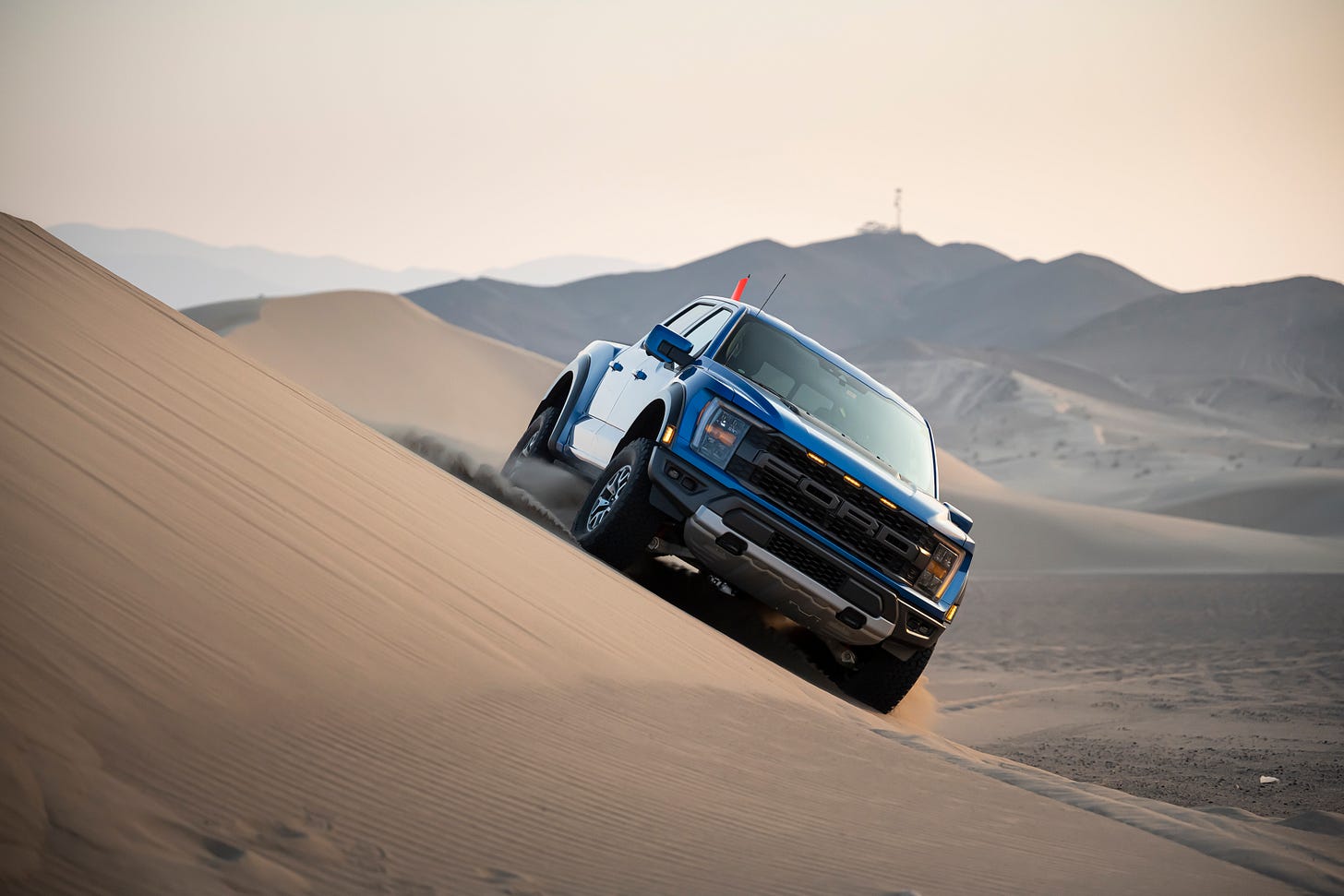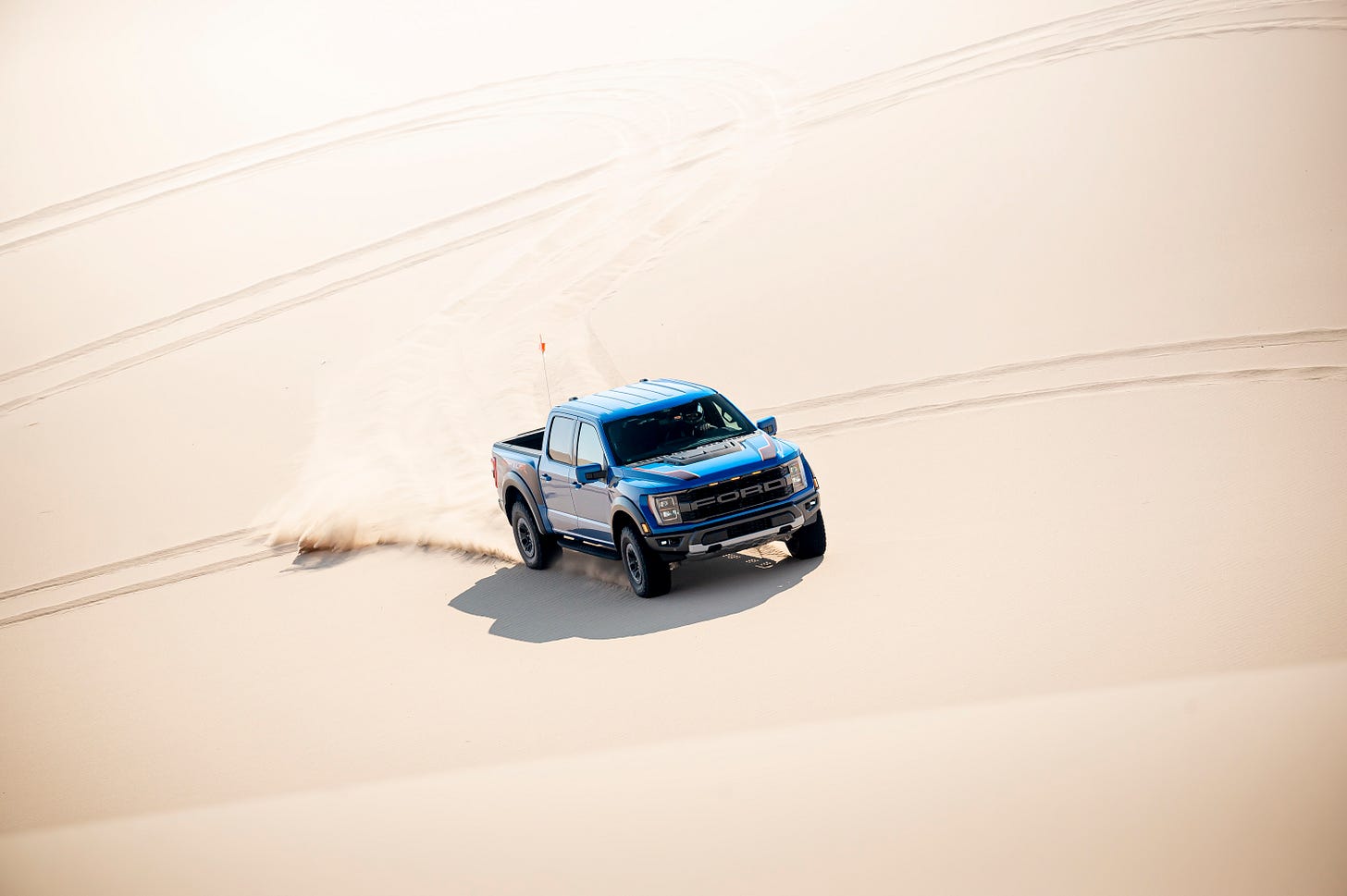2021 Ford F-150 Raptor First Drive
With bonus video review!
Ford invited me to drive the new 2021 F-150 Raptor in the sand dunes of the Mojave Desert. My friend Tim Esterdahl was jealous but still asked me to shoot a video for his YouTube channel Pickup Truck Plus SUV Talk. I also wrote a review for his website at PickupTruckTalk.com and he was kind enough to let me republish my words here. Make sure to like, comment and subscribe to the video on YouTube! Enjoy.
For more than a decade, the Ford Raptor has been the off-road pickup king. Now the third-generation 2021 Raptor is here, and, according to Ford Motor Co., it’s the best Raptor yet.
Ford took us out to the Mojave Desert for a day in the dunes to test that claim.
Suspension tweaks
The new Raptor is the first F-150 to have a five-link rear suspension that Ford says is inspired by high-performance off-road racing trucks. As an added bonus, it makes the on-road ride much smoother. It’s wild to think that the new Raptor might be the most comfortable pickup Ford sells, but with all the fancy suspension work, that might be the case.
In addition to the suspension changes, the live valve FOX Racing shocks have been upgraded at all four corners. They have twice the compression control, thicker bodies, a 1-inch shaft (on the 37-inch tires), and a nine-zone damping tune. So the shocks can handle whatever is coming their way regardless of the surface.
A litany of different drive modes allows you to customize things depending on conditions. Spin the drive-mode knob left to get from “Normal” to the on-road options: Slippery, Tow/Haul and Sport; or to the right to get off-road options: Off-Road, Rock Crawl and Baja.
One tick to the left and you get Sport, which is the best on-road option. It firms up the suspension and steering, opens the exhaust to the second most-ferocious setting as well as tweaks engine and throttle mapping for the best pavement performance.
Adjusting the exhaust note
That exhaust is particularly interesting. During the development of the new Raptor, Ford found the length of the exhaust piping affected the exhaust note. The muffler is located on the right side of the chassis, a little more than halfway down the track. Because of its position, the exhaust pipe from the left engine bank is a bit longer than the pipe from the right bank. This affected the resonance of the exhaust note and, basically, made it sound awful.
To fix it, Ford engineered a “trombone” loop into the right-bank exhaust pipe. This makes them the same length and dramatically improves the exhaust sound. It’s a clever piece of design and one that Ford swears is solely for audio purposes and doesn’t have any effect on performance.
Dedicated mode buttons on the steering wheel allow for customization without changing the drive mode. Steering, suspension and exhaust can all be adjusted individually. The exhaust even has a “Quiet” mode, which closes the butterfly valves entirely, forcing the exhaust through a third, quieter pipe out of the muffler.
Quiet mode is very effective if you’re sneaking home late at night or don’t want to rattle the neighbors when you get up for work. Or if you want everyone to know you have a Raptor, you can manually activate Baja mode at any time, and the truck absolutely roars.
Whoops and washes
We left Pahrump at 4:15 a.m. to drive out to the Dumont Dunes OHV area in the Mojave Desert — almost 12 square miles of stunning sand dunes ready to be pounded into submission.
We started with an overlanding adventure, basically a slow(ish) jaunt across the desert from the highway to our base camp. We hit some dunes, a surprisingly challenging hill climb, and a whole lot of washboards that would have been much nicer at higher speeds.
I got stuck once when the Raptor in front of me in our convoy decided to stop at the top of a hill, leaving me stranded behind him on the uphill portion. But with careful application of the throttle, my Raptor — complete with 37-inch BFGoodrich KO2 tires — was able to slowly climb out of it.
Once out on the sand, we had four courses to test our skill and the Raptor’s performance. As one Ford engineer put it to me, there probably wasn’t anyone there (including all the Ford employees) whose skill exceeded the Raptor’s abilities.
There was a whoops course, a high-speed run down a desert wash, a sand dunes course and, finally, a rally stage that incorporated bits of all of the above.
Ready to roll from the dealership, a prior-generation F-150 Raptor completed the Baja 1000 (placing third in its class) with only a safety cage added per regulations and then drove home to Phoenix. To say the Raptor was on familiar ground would be an understatement.
After being fitted with a helmet and HANS device to make Ford’s legal department happy, we hit the bumpy, wavy whoops course, where I learned the importance of a good start. We didn’t have a long run-up to build speed, so those first 10 yards were critical. Get it right, and you could get close to 70 MPH by the end. Spin the tires too much, and you’d barely make 55.
It wasn’t a smooth ride, but it was far better than I would have expected. Prior Raptors would have made good time but wouldn’t be nearly as comfortable doing it. And, as Ford explained it to me, thanks to the new rear suspension, 37-inch tires and increased wheel travel, the rear tires end up in contact with the ground more across the whoops. That makes you faster.
The wash was even more fun, combining slippery sand with rutted trails and long, high-speed sections. The Raptor was predictable and controllable, which is precisely what you want from a powerful truck. Power slides were easy to manage if you’re going to show off, and the 37-inch tires gobbled up the distance. Trust in the ruts, they said, and it was like driving on rails. Launching into a corner at 60 MPH and trusting the ground to steer you is an exercise in bravery, but it works.
Desert drives and dunes
Ripping through the Sand Dunes is some of the most fun you can have, though it’s a much slower ride. Maintaining momentum is the name of the game: AKA, don’t stop on an uphill because then you’re in for an embarrassing back-up maneuver to a flat section.
The Raptor loved the dunes, though a pair of trucks did see their tires ripped off the wheels. That was perhaps thanks to some overly enthusiastic driving into sharp corners, though it illustrated beadlock tires’ usefulness. Both the 35- and 37-inch BFGoodrich KO2 options on the Raptor are beadlock-capable, though thanks to DOT regulations, you can’t buy them that way from the factory.
Instead, there’s an aftermarket Ford Performance part that you can buy if you want to beadlock your tires in the knowledge that you can’t legally drive those on the road once you do so.
The rally stage combined everything into one epic rip-roaring good time. However, we weren’t making timed runs, which was disappointing because we car journalists are a naturally competitive lot.
Off-road happy + tech-savvy
The 2021 F-150, the regular one, is the most refined pickup Ford has ever built. It’s packed with tech and clever features to make your life easier and more comfortable. And all that makes its way over to the new Raptor.
You get a big 12-inch digital dashboard, with which folks seem to have a love/hate relationship, as well as the colossal center screen with numerous cameras (including a forward-facing trail camera when you switch into Baja Mode). There’s wireless Apple CarPlay and Android Auto, a Wi-Fi hotspot, the retracting gearshift and flip-open workstation, and even the wildly useful Pro Power Onboard generator good for 2 kilowatts of juice.
The value of all that electricity is obvious for desert running, allowing you to run things like air compressors and other tools wherever you might be. But it also serves up creature comforts such as televisions and stereos for a late-night party out on the sand.
Ford Raptor-specific stuff
The optional Recaro bucket seats are very comfortable and keep you in place when the going gets rough. Those, plus other tweaks on the inside (as well as lots of Raptor badging) remind you that this isn’t a run-of-the-mill F-Series.
The new Raptor doesn’t look too different from the prior generation, as Ford choose to go for nips and tucks for 2021 rather than a fundamental rethink. The federally mandated amber indicators on the front grille have been redesigned in an attractive blade style (making them look even bigger), and the F-22 Raptor-inspired functional hood vents look even better.
The daytime running lights have been changed from the standard F-150 to be amber instead of white, so you’ll be able to tell a Raptor at a distance just from the DRLs.
An electronically locking rear differential is standard, while a TORSEN front limited-slip diff is an option. Payload is up by 200 pounds from the prior generation, going to 1,400 pounds, while max towing is also up by the same amount. The new Raptor is good for 8,200 pounds there.
And all the fancy F-150 tech is here, including trailer theft alert, trailer light check, Pro Trailer Backup Assist, app connectivity and more. Ford says that future over-the-air updates could add features from the Bronco like Trail Turn Assist.
The bottom line on the 2021 Ford Raptor
While Raptor has been the off-road pickup truck king, there’s a new truck in town vying for attention, and we’d be remiss in concluding this review without mentioning the all-new Ram TRX. From what we can tell in our brief test, the TRX will absolutely best the Raptor in top speed and quarter-mile sprints, but the Raptor bests the “apex predator” in off-road capability and, well, everything else.
But here’s the thing. What TRX did to Raptor is exactly what the new Ford Bronco just did to the Jeep Wrangler. After 10 years there’s finally some competition, and that’s driving innovation. This engine isn’t new in the Raptor, but the suspension has been very extensively reworked and the addition of 37-inch tires from the factory is particularly cool and exciting.
TRX had a hand in that.
What I particularly love about the new Ford Raptor: You can pick it up at your local Ford dealer and then head straight to the dunes without another stop. Or you can drive it every day and get all the creature comforts and technology of the regular F-150, knowing you could get just about anywhere off-road if you wanted to.
A couple of years ago, I attended the Baja 1000 race down in Mexico. I stayed at the same hotel in Ensenada as many of the race teams did, and the parking lot was filled with their support trucks — all of them were Raptors.
To me, there’s no better endorsement. And after my day in the dunes, it’s easy to see why.











